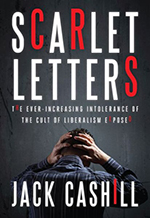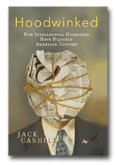How to Educate a Kid on $10 a Day
Jack Cashill's newest book will be out August 4th:
“Scarlet Letters: The Ever-Increasing Intolerance of the Cult of Liberalism Exposed"
![]()
© Jack Cashill
Published in Ingramsonline.com - May 2015
You can’t assess public-school finance without an honest look at the numbers.
The teachers at Padre Pio Academy in Shawnee watch the hysteria about Kansas public school budgets, I imagine, much the way Gary Butler watches the hold-out of Pittsburgh Steelers’ wide receiver Antonio Brown. Brown, you see, is refusing to report to camp. And who can blame him? Three years into a seven-year, $43 million contract, Brown sees other, presumably lesser mortals making more, and so he does what any self-respecting football diva would do. He sulks.
Butler, a linebacker for the Pittsburgh Power in the Arena Football League, does not quite feel Brown’s pain. He makes $14,940 for a regular season that is two games longer than Brown’s and is happy for the opportunity. “It’s not luxury,” says Butler, “but it’s a choice you make. You’ve got to be grateful.”
The teachers at Padre Pio are grateful, too. Salaries start at $21,000 a year and don’t get much higher. Like Butler, they love their work. Their willingness to teach for so relatively little is one reason that Padre Pio is able to educate its 60-plus students, K-through-8, at roughly $3,650 a year. Tuition covers about half the cost. Fund-raising covers the rest.
The spirit of Antonio Brown haunts the Kansas public school hegemony. When Kansas state Sen. Jeff Melcher mentioned recently on KCUR that the Shawnee Mission District was spending more than $15,000 per student per year—four times per capita the cost at Padre Pio—he caused heads to explode across the metro.
One of those heads belonged to Steve Rose, the eminence grise of the Johnson County Whig establishment. In a “special” to The Kansas City Star, Rose dressed down Melcher with a severity not seen since my fourth-grade nun hung up her yardstick. Melcher, fumed Rose, “did a smear job on the district with figures that are a perverse distortion of the truth.”
In fact, though, Melcher was on the money. Literally. He simply counted the costs the Shawnee Mission District included in the figures it posted on its Web site, among them capital outlay, bond debt, and KPERS contributions. A school district can no more ignore these costs than a homeowner can his mortgage payment or his contribution to his 401(k). They count.
Disregard the weepy headlines. For the past four years now, Kansas has been spending more money each year on K-12 education than it did the previous year. The much lamented “cuts” in question this year meant only that the increases would be slightly less than projected. Despite the “cuts,” the average teacher salary in Shawnee Mission rose from $65,061 last year to $66,961, roughly three times the salary of a Padre Pio teacher.
In the Shawnee Mission district, as elsewhere, administrators make nearly twice as much as the teachers. In the Blue Valley School District, 74 employees, almost all of them administrators, make more than $100,000 per year. At Padre Pio, the chief administrator volunteers.
This past school year, the Kansas City, Kansas, district found money in its budget to buy a $48,000 piano. It also found the money to pay its superintendent $234,000, despite the fact that at the district’s Wyandotte High School, only 5 percent of the students are “proficient” in math. If the football coach produced numbers like that, he’d be fired.
A school district can no more ignore capital outlays, bond debt and teacher retirement costs than a homeowner can ignore his mortgage payment or 401(k) contributions.
The piano at Padre Pio costs about $47,000 or so less, but close to 100 percent of its students are proficient in math. The school has no pool, no gym, no cafeteria, no buses, no air conditioning. Parents bring the kids. The kids bring their lunches. They all wear uniforms. When it gets hot, everyone sweats a little. At recess, everyone goes outside and runs around. It is much like the grade school I attended—the building is of similar vintage—but there are about 40 fewer students per class.
I toured Padre Pio recently as part of the evaluation team in the school’s accreditation process. In each class we entered, the students stood unprompted and greeted us in unison. In the eighth-grade class, I asked the students whether anyone could tell me when the American Civil War started.
I was moved to ask the question after watching a recent video shot at Texas Tech University in which student after student was stumped by the question, “Who won the Civil War?” Said one typical respondent, “Who was even in it?” At Padre Pio, a boy shot up his hand and said, “1861.” Warning: Do not try this stunt at home. You will be disappointed.
The fifth-graders, I was told, were studying the Renaissance. I asked them who introduced the printing press to Europe. Every hand shot up. That, by Padre Pio standards, was a no-brainer.
In the second-grade classroom, one boy volunteered that he would soon be 8½ years old. Aware that Padre Pio kids still do multiplication tables, I then asked them how many months in 8½ years. Working together without pen or paper, the kids took less than 30 seconds to get the right answer. (Correct, 102!)
The kindergartners were practicing their phonics—say “new math” or “whole language” at Padre Pio, and you get your mouth washed out with soap. The kids move on to the first grade only after they learn how to read.
The eighth-graders have kindergarten buddies they look out for. The seventh-graders have first-grade buddies. The older kids learn responsibility and take their roles seriously. Whichever educator thought it would be a good idea to remove kids this age from their natural hierarchy and mix them into an overheated “middle school” bouillabaisse should be forced to translate Common Core manuals into Pig Latin.
And yes, Virginia, let me anticipate your objection, Padre Pio has had some great success with troubled kids. One reason why is that the school is blessedly free of “bullying.” When kids start their days with prayers and a pledge of allegiance, they hold themselves to a higher standard.
The Padre Pio model may not be scalable, but the sentiment behind it should be. “It’s a choice you make,” Gary Butler reminds us. “You’ve got to be grateful.”





